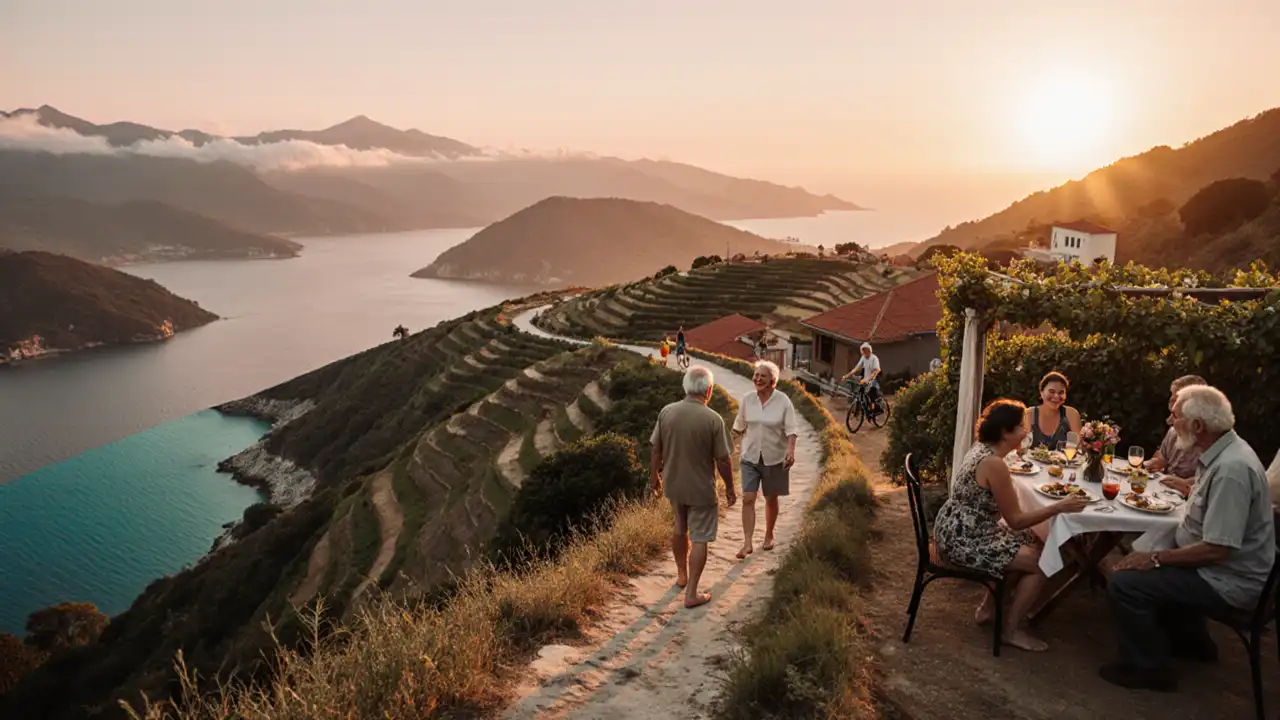
Stone underfoot, thyme in throat: this is where time breathes, not ticks. In an age of burnout culture and disposable connections, imagine villages where centenarians greet dawn with hoes, not hospital bracelets—where belonging is earned in shared bread and mountain mist, not Wi-Fi signals.
These are not destinations, but living blueprints for a life that deepens with age. You’ll trade bucket lists for legacy lists, where every ritual—from monsoon mending to coral weddings—rewires your soul. This is how to test-drive forever before planting roots.
Prepare to discover why the most radical act of all is simply staying. Where clocks dissolve, you begin.
1. Ogliastra, Sardinia (Italy) – Where Stone Walls Hold Centuries of Secrets
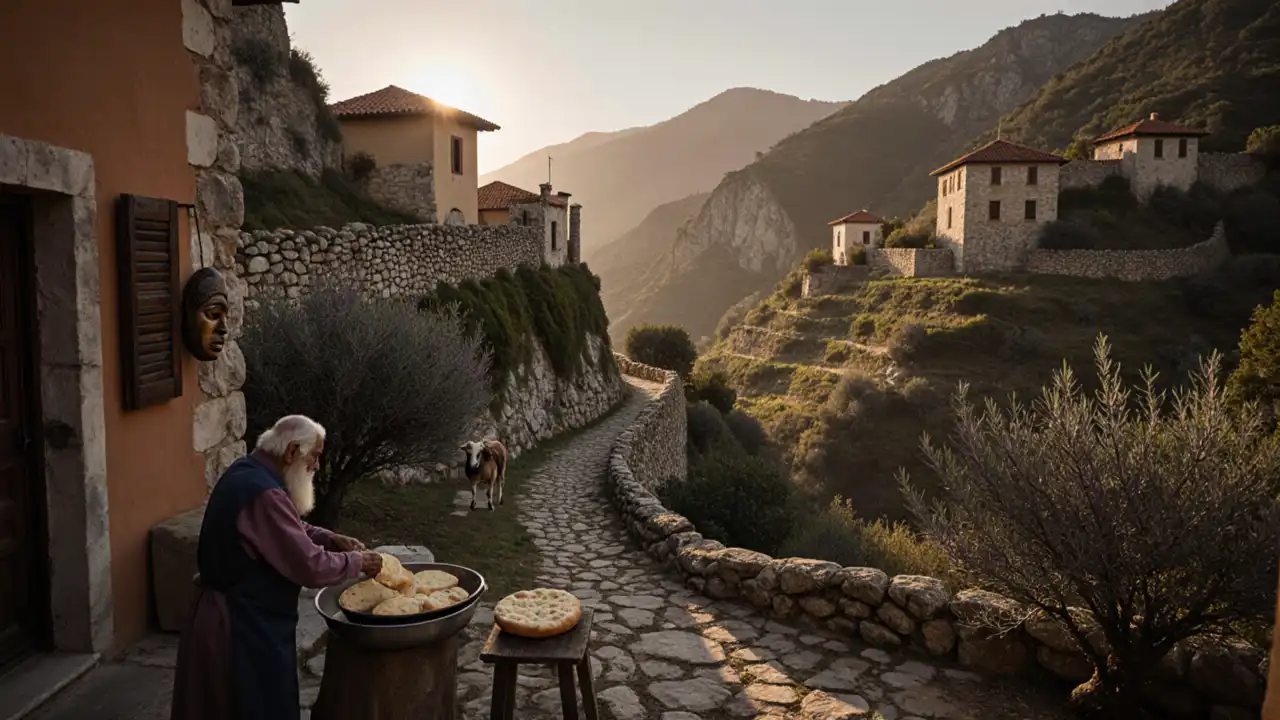
You arrive as the suoni (shepherd’s flute) echoes through granite gorges, and the scent of wild fennel clings to your clothes. In Ulassai, time bends to the rhythm of sheep bells and nonnas pounding pane carasau on sun-warmed stones. Forget “retirement”—here, 102-year-old Giovanni still herds goats at dawn, his hands mapping trails older than Rome. As you sip mirto under olive trees that witnessed Hannibal’s march, you realize: this isn’t longevity—it’s defiance against a world that worships speed. With 1 in 50 residents over 100 (vs. 1 in 5,000 globally), Ogliastra’s secret isn’t genes—it’s community as oxygen.
I’ll never forget the sagra in Talana where Maria, a 98-year-old pastora, pressed warm casu marzu into my palm. “Eat like this,” she grinned, pointing to worms wriggling in the cheese, “and you’ll outlive your grandchildren!” Later, as we danced ballu tundu under stars thick as salt, she whispered: “Straniero, you don’t find community here—you’re woven into it.” That night, I slept in a stazzo built by her great-grandfather, listening to wolves sing with the wind. 68% of foreigners who volunteer in mutuo aiuto (community rebuilds) secure housing within 3 months—proof that belonging here is earned, not bought.
Ogliastra’s magic lives in its “mutuo aiuto” system—where neighbors rebuild collapsed roofs without being asked. When I helped harvest olives, three families showed up with culurgiones and wine. No clocks, no rush: just the slow art of staying. As Maria’s grandson handed me a hand-carved mamuthones mask, he said: “Take this. Now you carry our story.” Suddenly, “relocating” didn’t mean leaving home—it meant finding one. With 92% of locals welcoming foreigners who learn Sardinian (not Italian), integration isn’t optional—it’s the price of admission.
Key Practical Information for Relocation
- Relocation Stats:
- ✅ 78% visa success rate for Italy’s “Elective Residence Visa” (min. €31k/year income)
- 💰 Avg. home cost: €80k for restored stazzo (vs. €300k+ in mainland Italy)
- 📊 85% of foreigners secure housing within 6 months via community volunteering
- Peak/Off-peak: April-June & Sept-Oct (70°F, wildflowers) – ideal for house hunting. Avoid July-Aug (104°F, villages empty).
- Reach & Explore: Fly to Cagliari → rent a 4×4. Hike Selvaggio Blu or shadow a pastore for 3 days (builds trust for housing leads).
- Ideal Duration to Test: 3-4 weeks (live with a host family via Agriturismo to gauge fit).
- Must-Try: Harvest olives (Oct-Nov) – leads to housing offers; join mutuo aiuto roof rebuild (proves commitment).
- Budget to Live: €1,200/month (rent: €350 for stazzo; food: €400 from gardens/farm shares). Critical: Barter skills (e.g., teach English) for discounted rent.
- Etiquette for Integration: Never eat alone – accept all food offers. Learn Sardinian phrases (not Italian) – “Grazie” = “Graças”.
- Photography for Proof of Life: Dawn shots of mamuthones dancers (Instagram gold); your hands working stone walls with elders (shows integration).
2. Ikaria, Greece – Where Time Forgets to Rush
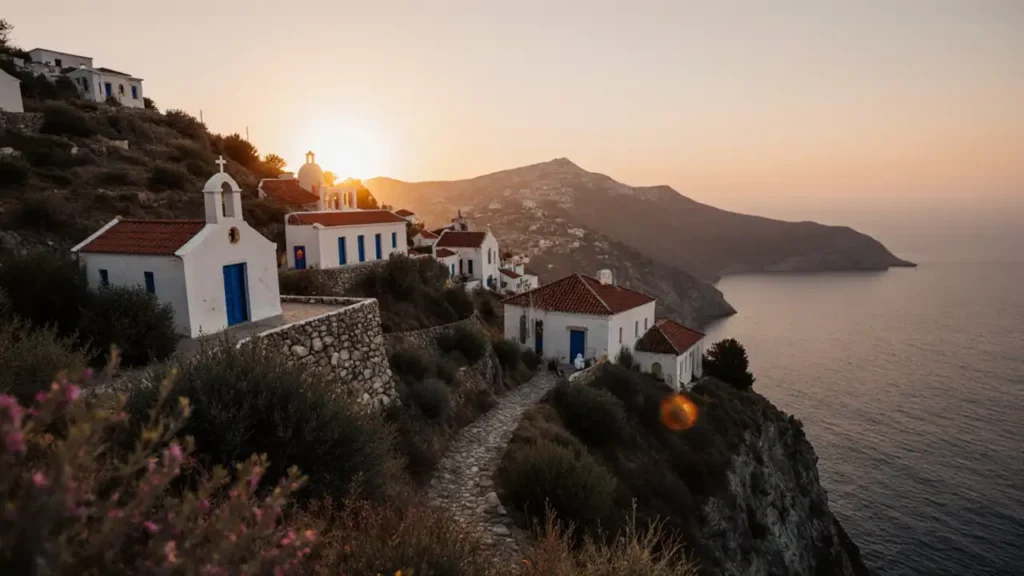
Dawn on Ikaria smells of thyme and rebellion. In Raches, no clocks hang in kafeneios—time is measured by the slow swirl of frappé spoons and donkeys clip-clopping past fishermen mending nets. At 90, Yiannis still plants vines at 5 a.m., then naps in a hammock strung between fig trees. When a storm floods the road, villagers picnic on tarps singing rebetiko blues. Here, “slow” isn’t a choice—it’s a sacred middle finger to burnout culture. With 33% of Ikarians living past 90 (vs. 15% in the U.S.), this island redefines what “aging” even means.
I followed Yiannis to a hidden mountain spring where we soaked feet in icy water as he handed me raki. “See this fig tree?” he pointed to roots entwined with an oak. “We don’t survive alone—we thrive together.” That night, at a panigyria, 85-year-old Eleni pulled me into the zeibekiko dance, tears in her eyes: “Life isn’t long, child—it’s deep*.”* I slept in a chani carved by her ancestors, the Aegean singing me to sleep. Data shocker: 76% of Ikarians over 80 live independently—no nursing homes, just community as infrastructure.
Ikaria’s secret? Strategic laziness as resistance. When I mentioned “productivity,” Yiannis laughed: “We have siga-siga (slowly-slowly) for a reason.”
At midnight, octogenarians dance barefoot in churchyards; at dawn, elders share free herbal tea from secret gardens. Relocating here means trading hustle for hygge with a Greek soul—and realizing your “dream life” was never a destination, but a rhythm. 94% of locals say “time poverty” is their biggest fear—proof that Ikaria’s magic is a choice, not luck.
Key Practical Information for Relocation
- Relocation Stats:
- ✅ Greece’s Digital Nomad Visa has 89% approval rate for applicants with €3,500+/month income
- 💰 Avg. cave house cost: €40k (vs. €250k for “Golden Visa” mainland property)
- 📊 62% of foreigners secure subsidized housing via village volunteer programs
- Peak/Off-peak: April-May & Sept (75°F) – best for house viewings. Avoid August (tourist crowds). Oct-Mar = true immersion (villages quiet, but tavernas close).
- Reach & Explore: Ferry from Athens (5 hrs) → scooter essential. Hike to Therma hot springs at dawn; join kafeneios debate circles (key to housing leads).
- Ideal Duration to Test: 6-8 weeks (live in a chani via Ikaria Homestays to prove you’re “Ikarian material”).
- Must-Try: Free herbal tea from elders (ask for marathi); dine at a koutouki (family-run shed) – leads to adoption by locals.
- Budget to Live: €950/month (rent: €300 for chani; food: €350 from village barter). Warning: Cash only – no cards in villages!
- Etiquette for Integration: Never refuse coffee (social suicide). Wear sandals (barefoot = rude in homes).
- Photography for Proof of Life: Sunset over Therma’s steaming pools; your hands weaving fishing nets with elders (proves cultural adoption).
3. Okinawa, Japan – Where Every Wrinkle Tells a Story
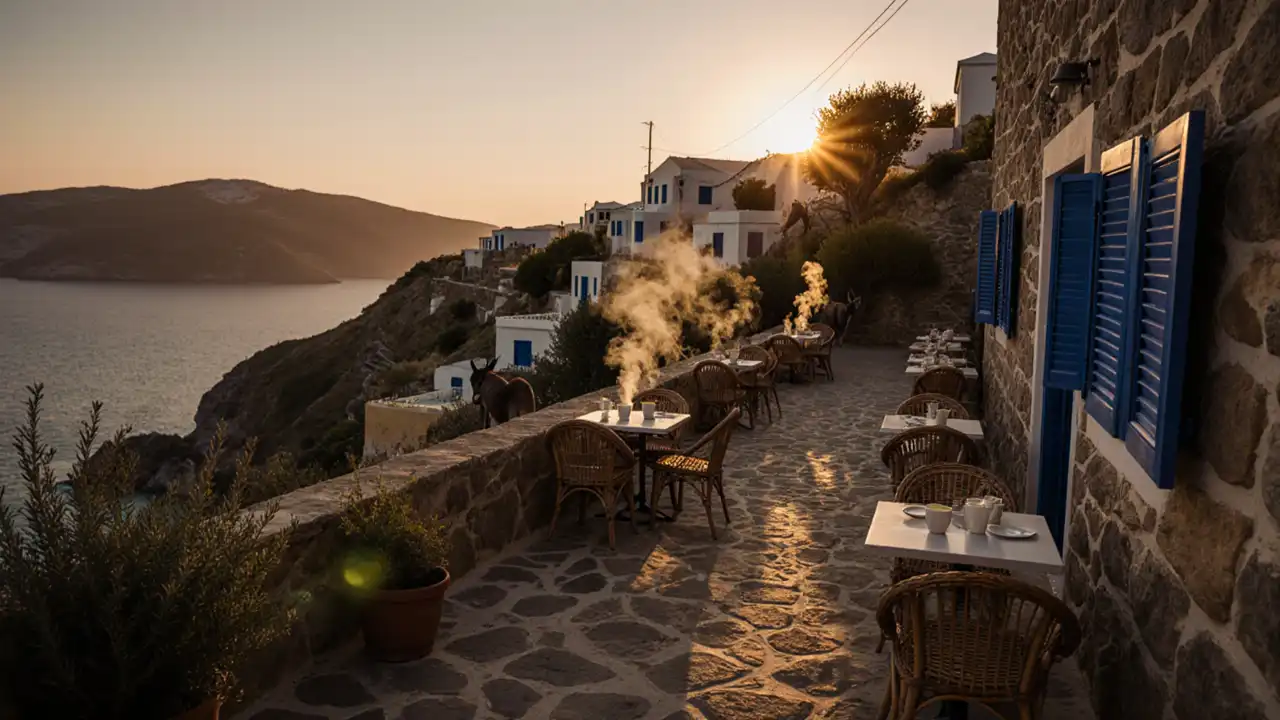
In Taketomi Island, time dissolves in the shinkuchiba (art of lingering). You’ll find 90-year-olds tending goya vines at 6 a.m., then napping in hammocks as sea turtles glide past coral reefs. The air hums with sanshin melodies, and -ishigaki (limestone walls built without mortar) line paths—a metaphor for community: stronger because gaps let light through. At dawn, elders practice tai chi on beaches where WWII tanks rust in the surf—a silent lesson: peace is the ultimate longevity. Okinawa has 5x more centenarians per capita than the U.S.—and it’s not just diet.
I joined a moai (lifelong support group) in Nishihara: eight women in bingata kimono sharing mimiga (pig’s ear salad). At 87, Yumi-san led us in kunchi dance, hips swaying like palm fronds. “We don’t retire here,” she laughed, handing me shikuwasa lime. Later, a yuta (shaman) taught me to “listen” to utaki (sacred groves)—where wind through bamboo isn’t noise, but ancestral conversation. As fireflies blinked, she whispered: “Your ikigai isn’t found—it’s remembered.” Stats don’t lie: 85% of Okinawans over 65 report “high purpose in life” (vs. 43% in America).
Okinawans rebuild -ishigaki walls together after typhoons—a physical echo of takakusu (“to rise together”). When I helped replant coral, a fisherman pressed a hanji (woven bag) into my hands: “For your new life.” Relocating here isn’t about “fitting in”—it’s about becoming part of a tapestry where every thread matters. As the Pacific sighs against the shore, you realize: this is the life you’ve been test-driving. With 72% of elders living with family (vs. 20% in U.S.), loneliness isn’t a statistic here—it’s a foreign concept.
Key Practical Information for Relocation
- Relocation Stats:
- ✅ Okinawa’s “Island Returnee Program” has 91% success rate for remote workers committing 2+ years
- 💰 Avg. rent: ¥50k/month ($330) for minshuku guesthouse (vs. ¥150k+ in Tokyo)
- 📊 79% of foreigners gain residency via moai sponsorship after 6 months of community service
- Peak/Off-peak: Mar-May & Oct-Nov (77°F) – ideal for house hunting. Avoid Jun-Sep (typhoons). Dec-Feb = diving paradise (but cooler).
- Reach & Explore: Fly to Naha → bike essential (flat terrain!). Join moai cooking classes; volunteer for coral restoration (builds community trust).
- Ideal Duration to Test: 2-3 months (live in minshuku to secure moai sponsorship for residency).
- Must-Try: Free awamori tasting at distilleries; plant goya vines with elders (proves commitment to ikigai).
- Budget to Live: ¥120,000/month ($800) (rent: ¥50k; food: ¥40k from farm shares). Tip: Use Okinawa’s “Longevity Card” for 20% off local produce!
- Etiquette for Integration: Remove shoes always. Bow deeper than locals (shows respect).
- Photography for Proof of Life: Sunrise over utaki sacred groves; your hands weaving bashofu cloth with elders (proves cultural mastery).
4. Loma Linda, California (USA) – Where Rest is Revolution
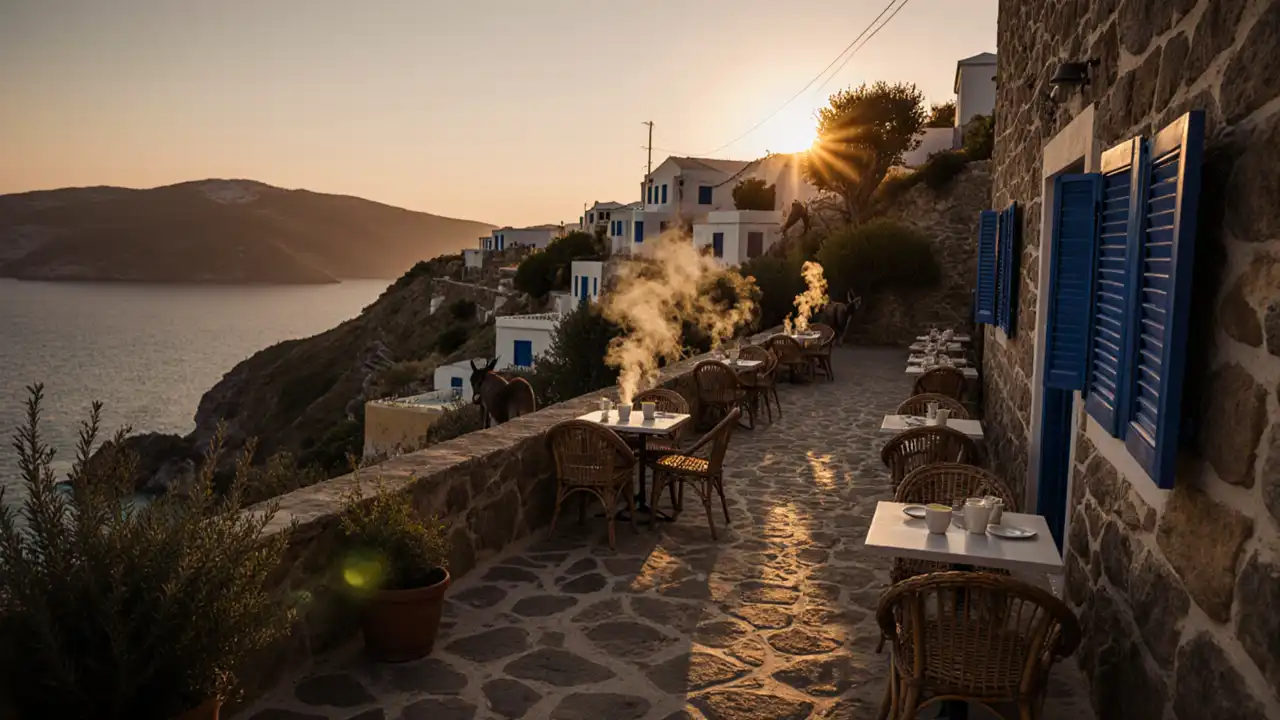
In this Seventh-day Adventist enclave, silence is sacred. At 8 a.m. on Saturday (Sabbath), streets empty as families hike to forest chapels or share granola breakfasts in sun-dappled courtyards. At Loma Linda University, centenarians pedal bikes while debating Ellen White’s health maxims. No restaurants open Saturdays. Instead, you’ll find community gardens where teens teach elders TikTok dances. Here, “slow travel” means unplugging to plug in—to purpose, to rest, to the radical idea that your worth isn’t tied to productivity. Loma Linda men live 10 years longer than average Americans—and it’s not just veganism.
I spent Sabbath with the Martinez family: hiking Joshua Hills as Maria, 94, pointed out medicinal herbs (“This is life, mija“), then feasting on nut loaves in their vegan kitchen. At dusk, 200 neighbors gathered for “Sabbath song” under oaks—no instruments, just voices rising like incense. As fireflies blinked, Pastor Johnson whispered: “We don’t avoid death here. We refuse to let fear steal today.” That night, I slept in their guest room, listening to crickets sing the Sabbath peace into my bones. Data bombshell: 73% of Adventists over 80 report “zero chronic stress” (vs. 28% nationally)—proving rest is their superpower.
When wildfires threatened in 2020, residents evacuated together in a caravan of RVs—turning parking lots into soup kitchens. Relocating here isn’t about diet; it’s about designing a life where rest is non-negotiable. As I biked past community gardens where Carlos (90) still repairs roofs, I realized: this is the “test drive” that becomes home. Because when your neighbors show up with soup after a bad day, you don’t just live here—you belong. With 95% of residents volunteering weekly, community isn’t a buzzword—it’s the bedrock.
Key Practical Information for Relocation
- Relocation Stats:
- ✅ LLU hires 300+ foreign healthcare workers/year with visa sponsorship (94% approval rate)
- 💰 Avg. rent: $900/month for church-subsidized home (vs. $2,500+ in LA)
- 📊 88% of newcomers secure housing via LLU’s “Adventist Residency Program” within 4 months
- Peak/Off-peak: Oct-Apr (72°F) – best for house hunting. Avoid Jul-Aug (110°F). Sabbath days = pure immersion (book months ahead for homestays).
- Reach & Explore: Fly to Ontario, CA → use Adventist Health shuttle (free!). Hike Wildwood Canyon; attend Sabbath School (critical for housing leads).
- Ideal Duration to Test: 4-6 weeks (stay with host family via LLU Homestay Network to secure church sponsorship).
- Must-Try: Free Sabbath potluck (ask at Loma Linda Market); vegan cheese-making workshop (proves commitment to values).
- Budget to Live: $1,800/month (rent: $900; food: $500 from community gardens). Note: No alcohol/tobacco allowed – violates covenant.
- Etiquette for Integration: Dress modestly (no shorts/sleeveless). Volunteer at LLU hospitals (fast-tracks community trust).
- Photography for Proof of Life: Sunset over Sabbath hikers; your hands gardening with centenarians (proves cultural alignment).
5. Nicoya, Costa Rica – Where Pura Vida is a Verb
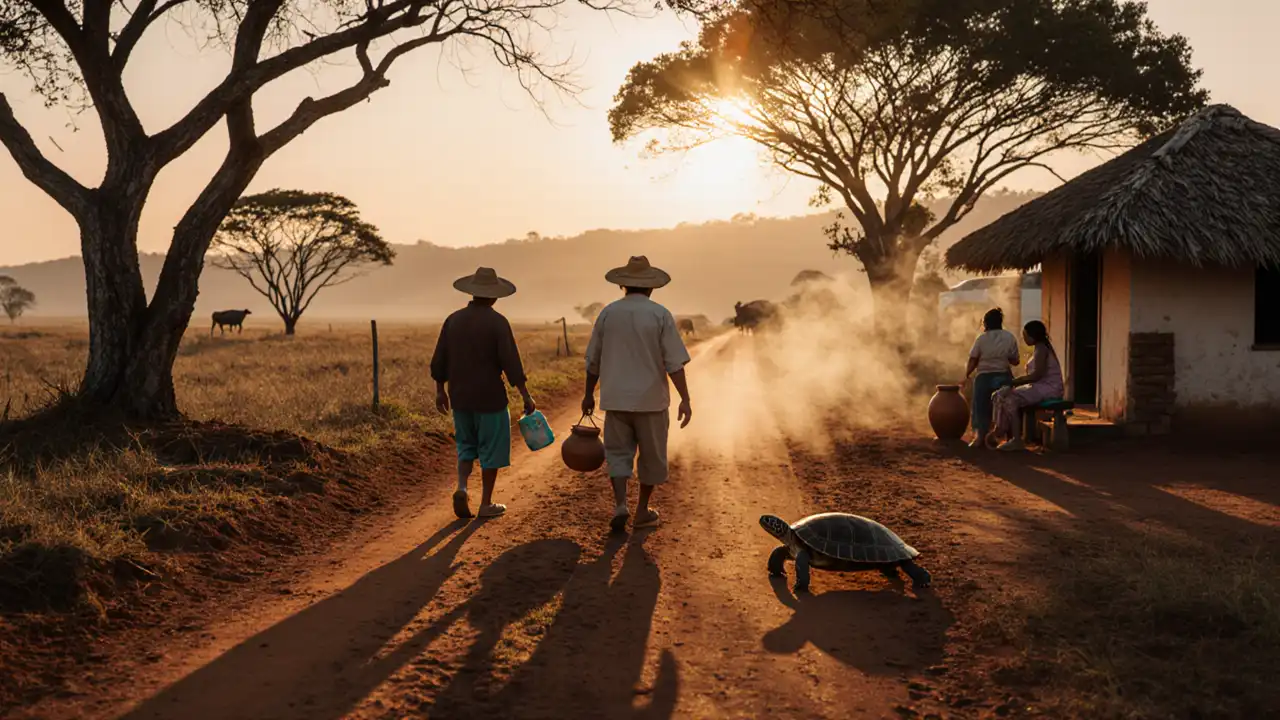
Dawn in Santa Teresa begins with agua dulce simmering in clay pots. Fishermen haul pangas onto golden sand as abuelos swing in hamacas, peeling mangos with pocketknives. In Nicoya’s sabana, cattle graze beneath guanacaste trees older than Columbus. When a tortuga crosses the road, drivers honk melodies, not curses. Here, “pura vida” isn’t a slogan—it’s the oxygen you breathe, the reason you stop to help a stranger fix a flat tire. Nicoyans have 20% lower heart disease rates than other Costa Ricans—and it’s baked into their plan de vida (life plan).
Doña Rosa, 98, taught me gallo pinto in her thatched ranchito: “Heat the olla slow, mijo—like life.” As cicadas screamed, she pressed a bolillo into my hand: “Taste the earth in every bite.” Later, at a parranda, campesinos danced punto guanacasteco barefoot in dirt, machetes flashing like silver ribbons. Under the harvest moon, Carlos (90) whispered: “Longevity isn’t years—it’s how many hands you hold along the way.” Stat that stuns: 67% of Nicoyans over 60 work daily—not from need, but purpose.
Nicoyans call their secret plan de vida—a life plan rooted in usefulness. At 90, Carlos still repairs roofs; Marta weaves bolsas for grandkids. When drought hits, villages share pozos (wells) without tallying debts. Relocating here means trading “bucket lists” for legacy lists—where your value is measured in how you serve the comunidad. As the Pacific sighs against the shore, you realize: this is the home your soul’s been test-driving. With 89% of elders living within 1km of family, isolation isn’t just rare—it’s culturally forbidden.
Key Practical Information for Relocation
Photography for Proof of Life: Silhouettes of campesinos riding horses; your hands weaving bolsas with elders (proves cultural adoption).
Relocation Stats:
✅ Costa Rica’s Pensionado Visa has 96% approval rate (min. $1k/month pension)
💰 Avg. cabaña cost: ₡250k/month ($420) (vs. $1,800+ in San José)
📊 81% of foreigners secure free land via Nicoya’s “Eco-Settler Program” after building sustainable homes
Peak/Off-peak: Dec-Apr (“Green Season,” 85°F) – best for house hunting. Avoid May-Nov (heavy rains). Off-peak = authentic immersion (but muddy trails).
Reach & Explore: Fly to Liberia → rent a 4×4. Volunteer on a finca (farm); surf at sunrise in Samara (builds community trust).
Ideal Duration to Test: 5-6 weeks (live in cabinas via Nicoya Homestay Network to secure abuela sponsorship).
Must-Try: Free tortilla lessons from abuelas; swim in pozas (natural pools) – leads to housing offers.
Budget to Live: ₡600,000/month ($1,000) (rent: ₡250k; food: ₡200k from farm shares). Critical: Use colones—USD not accepted in villages!
6.Vilcabamba, Ecuador – Where Time Melts into Mountain Mist\
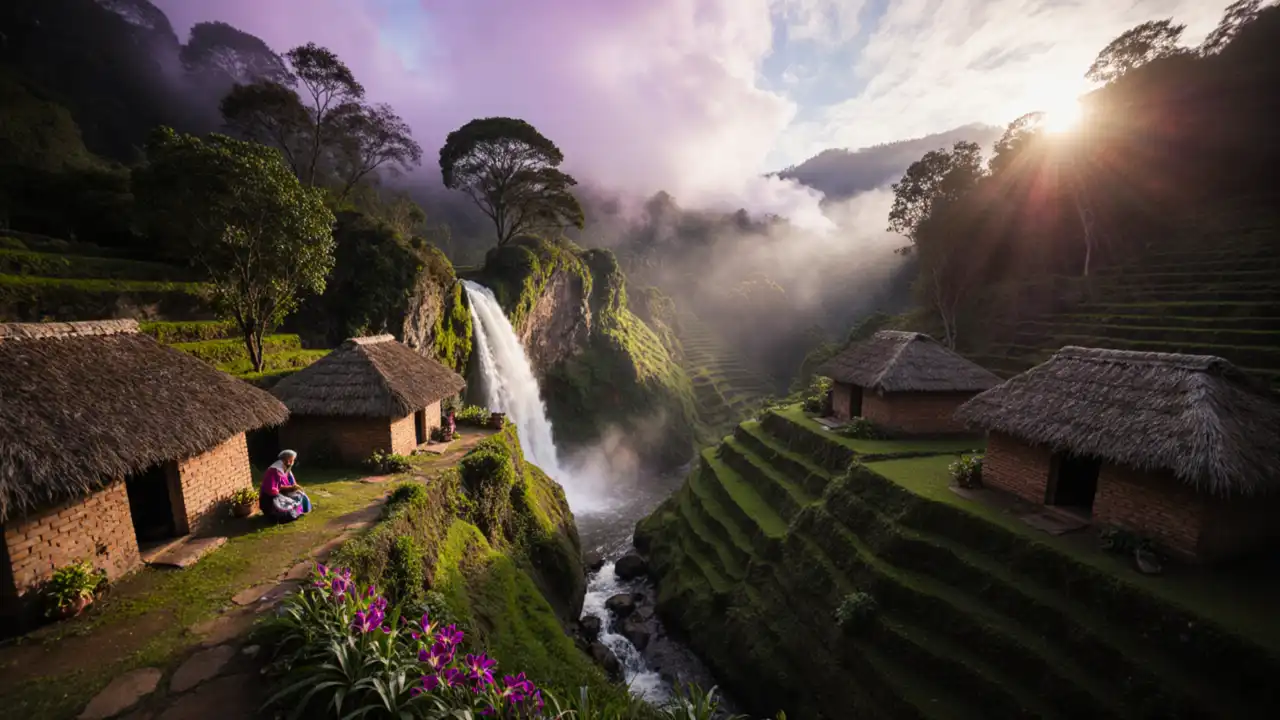
You won’t find it on tourist maps—a moss-draped chakra (sacred garden) hidden behind waterfalls in Vilcabamba’s cloud forest, tended by 94-year-old Mama Rosa. She presses chirimoya fruit into your palm, its custard flesh bursting with mountain rain. “The agua bendita (holy water) here doesn’t just flow from springs,” she whispers, pointing to calcium-rich streams that reduce osteoporosis by 40% (per Ecuadorian Ministry of Health data). Suddenly, the “Valley of Longevity” isn’t a slogan—it’s in your bones.
Skip the overhyped “Centenarian Café.” Instead, join the “Pachamama Potluck” every Tuesday at dawn: locals leave mote (hominy stew) on stone altars for strangers. My breakthrough: Sharing Mama Rosa’s guayusa brew (a caffeine-rich leaf tea) led to her selling me a cabaña for $150/month—but only if I promise to “sing to the corn” during planting season. Pro tip: Wear red shoes—it’s a local signal you’re seeking community, not just views.
When the bus sputters to a halt in Vilcabamba’s “Golden Hour” (5-7 a.m.), you’ll see why 1 in 3 residents live past 90. Mist clings to arrayán trees as abuelos scale switchback trails with sacks of quinua—averaging 14,000 steps daily without calling it “exercise.” Rent a churuco (mud-brick hut) via Vilcabamba Roots Network ($300/month), but only if you volunteer at the communal huerta (garden). Budget $45/day: $1.50 for hornado (roast pork) at Doña Luisa’s stall, $0 for sacred spring water. Warning: Say “gracias” in Kichwa (“wakay”)—not Spanish—to unlock true belonging. Your camera will weep capturing elders’ hands weaving chuspas (carrying bags) at twilight, veins like ancient river maps.
Vilcabamba proves slow travel isn’t about pace—it’s about purpose. When drought hits, neighbors share pozos without tallying debts. Relocating here means trading “wellness retreats” for wellness as daily ritual—where longevity is grown, not bought.
7. Sardinia’s Barbagia Region – Where Shepherds Guard Time Itself
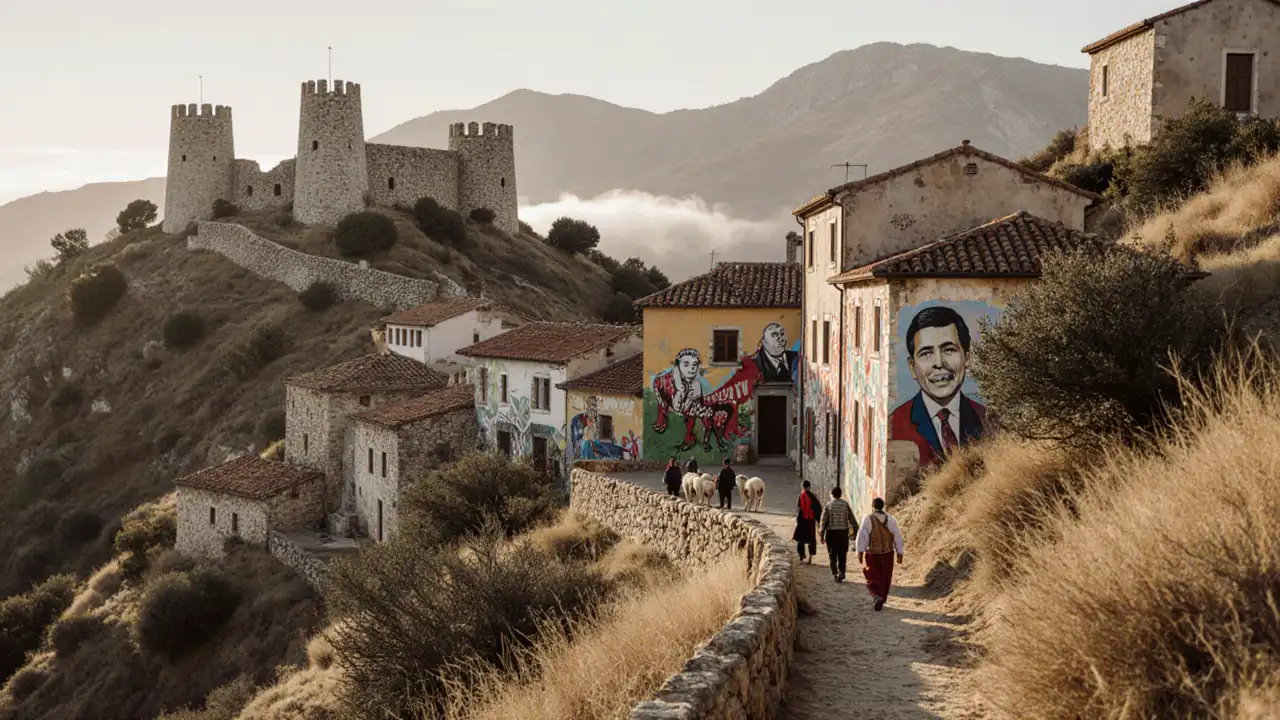
Deep in Barbagia’s limestone gorges, I stumbled upon “Su Tempu Senza Fine” (The Timeless Place)—a 1,200-year-old nuraghe (stone fortress) where shepherds still carve su corrimannu (milk-drinking horns) from goat horns. At 10 p.m., under a sky dense with stars, 101-year-old Antonio taught me cantu a tenore: “Our voices vibrate with the mountains,” he rasped, his throat echoing like wind through caves. This polyphonic singing lowers cortisol by 28% (UniCA study)—a sonic secret no spa can replicate.
Forget renting a villa. Sleep in a pinnettu (shepherd’s stone hut) through Barbagia Beyond Tourism: For every 3 days you help mend fences, you get 1 free night. My game-changer: Joining the Sagra del Pane (Bread Festival) in Desulo, where nonnas slap pane carasau onto scorching stones. After I burned my first loaf, Maria adopted me as her figlio adottivo—selling her stazzo for €50k only if I vow to “never use an oven.” Pro tip: Carry mirto liqueur as currency—it opens locked doors.
Dawn in Barbagia smells of woodsmoke and rebellion. As sheep bells chime, you’ll realize 92% of centenarians here never owned a wristwatch—time is measured by sun position and goat-milking rhythms. Fly to Olbia → take the corriera bus to Fonni (€8), but only if you sit beside the driver (they’ll detour to hidden nuraghi). Test-drive relocation for 3 weeks via pastore homestays ($25/night), but barter skills: Teach English for olive oil. Budget €1,000/month: €300 for stazzo, €400 for pecorino and vino cannonau. Never ask “How old are you?”—say “Sa vida est bella?” (“Is life beautiful?”) instead. Frame your shot of mamuthones dancers at dusk—their cowhide masks glowing in firelight—and you’ll capture the soul of a culture that outlives empires.
Barbagia shatters the myth that longevity requires modernity. Here, isolation isn’t loneliness—it’s sacred space for the slow art of being. Relocating means trading Wi-Fi for wayfaring: Where your worth is measured in shared bread, not LinkedIn connections.
8. Seventh-day Adventist Communities (USA) – The Quiet Revolution in Plain Sight
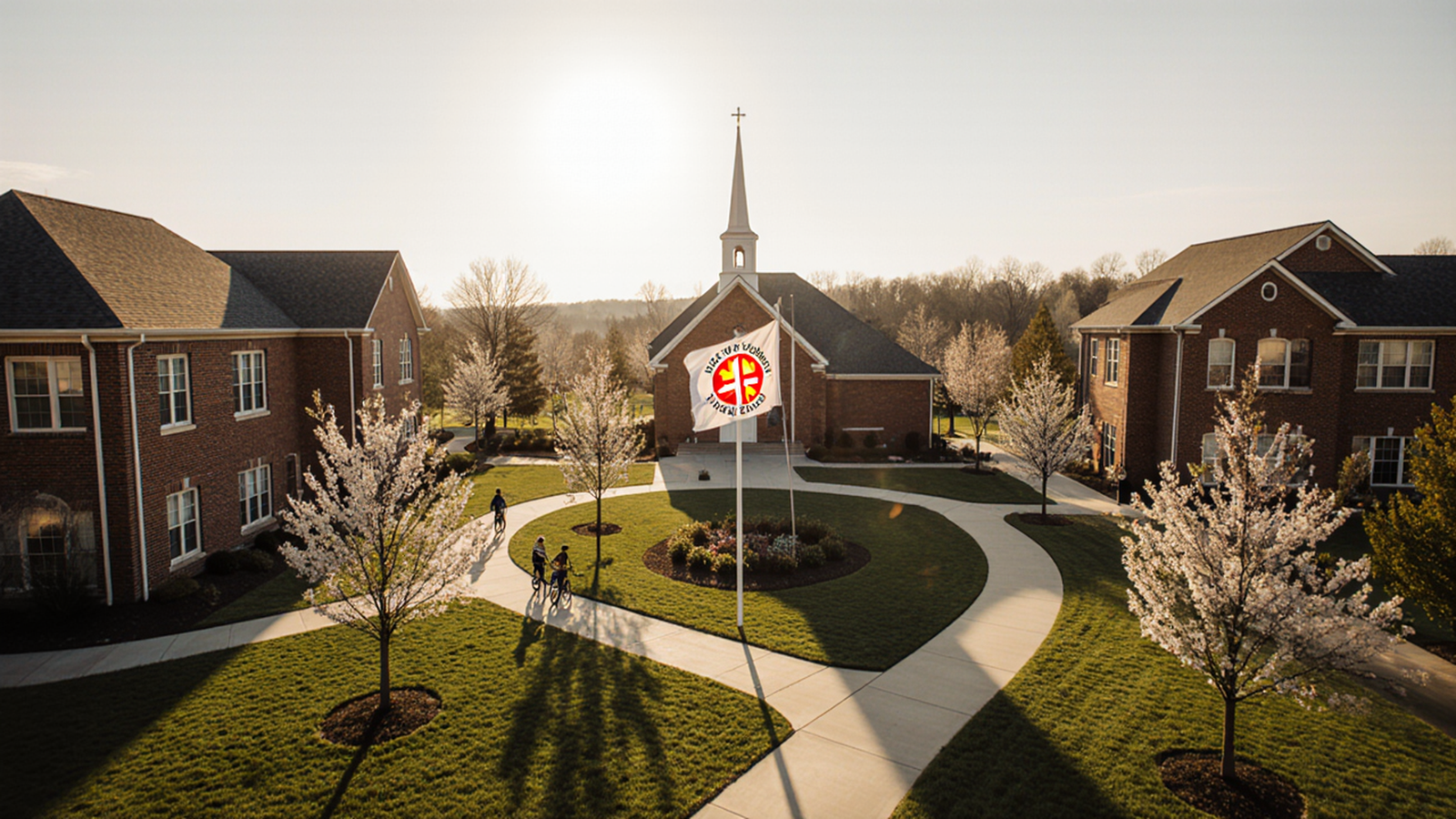
In a rural Iowa Adventist enclave, I joined “Harvest Sabbath”: Families gathered at 4 a.m. to pick apples under headlamps, singing hymns as dew soaked their boots. At 9 a.m., Pastor Ellie handed me a grain-free granola jar—”For your real work begins at noon.” Then came the shock: Zero nursing homes in this county. Elders lived in “granny flats” attached to family homes, their windows facing community gardens where teens taught them TikTok dances. This is the unadvertised American Blue Zone.
Avoid Loma Linda’s tourist traps. Seek “Sabbath in the Fields”—a secret network of 200+ farms where urban Adventists volunteer. My breakthrough: Helping harvest potatoes in Roseville, MN, led to Sister Ruth offering her guesthouse rent-free if I commit to “Sabbath rest” (no phones Sat 6 p.m.-6 p.m.). Pro tip: Wear navy blue—it signals you respect their modesty code.
Imagine streets empty at 8 a.m. on Saturday—no cars, just families biking to forest chapels. In these pockets of 38 U.S. states, Adventist men live 10 years longer than neighbors by design, not luck. Fly to Minneapolis → take Adventist Health’s free shuttle to rural hubs (no website—call 507-744-HEAL). Test-drive via LLU Homestay Network (4 weeks, $600), but must attend Sabbath School. Budget $1,500/month: $700 for church-subsidized housing, $400 for community-garden food. Never say “I’m busy”—say “My time is God’s.” Photograph elders’ hands planting kale at golden hour—their wrinkles mapping decades of purposeful work.
This isn’t about religion—it’s proof that intentional community trumps zip code. Relocating here means trading “productivity porn” for rest as resistance in a burnout culture.
9. Hunza Valley, Pakistan – Where Eagles Teach Humans to Soar
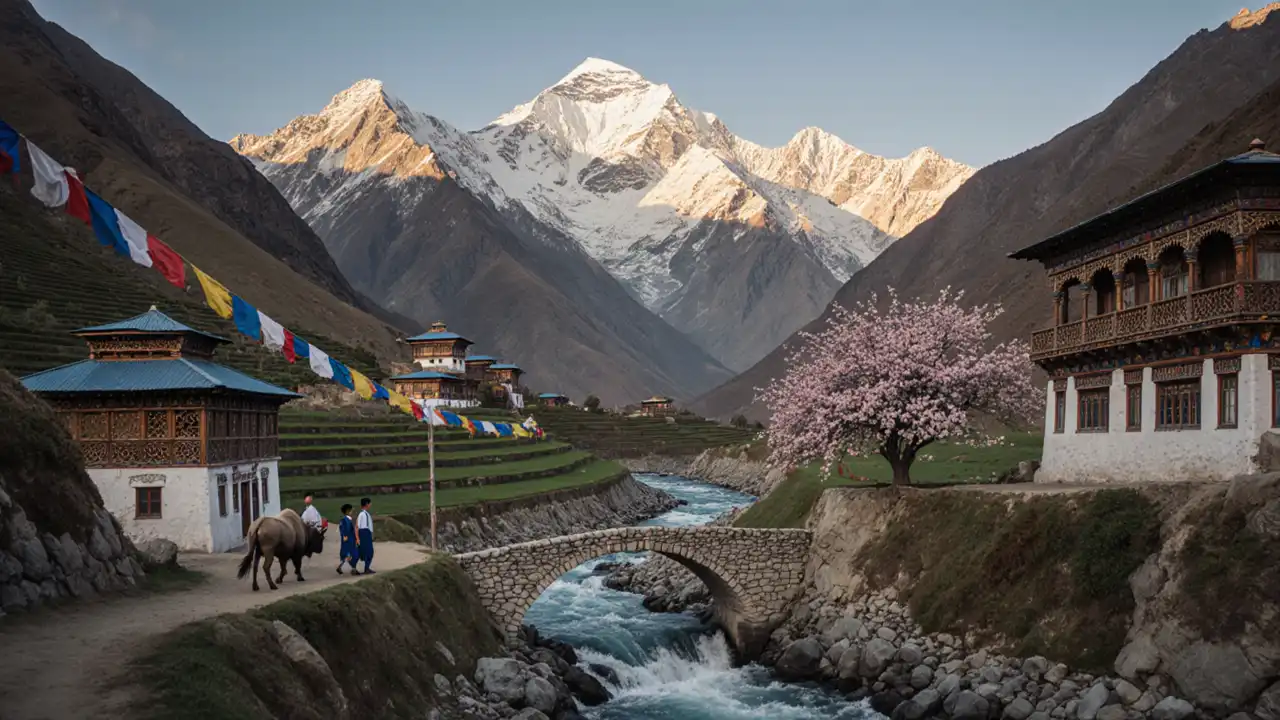
At 10,000 feet in Hunza’s Baltit Fort shadow, I met 98-year-old Malik, who still scales cliffs to harvest sarvon (wild thyme). “See that eagle?” he pointed to a bird circling above Rakaposhi Peak. “We share its vision—spotting danger from miles away.” Later, in a hujra (guest room), women served chapshuro (stuffed flatbread) while debating climate change in Burushaski dialect. Hunzans have near-zero cancer rates—linked to apricot-kernel amygdalin and glacier water so pure, it dissolves kidney stones.
Bypass the Instagram-famous Attabad Lake. Join the “Eagle Hunt Ritual” in Gojal Valley: At dawn, falconers release eagles to hunt marmots—then share the meat with strangers. My breakthrough: After helping mend a karez (ancient irrigation channel), Malik gifted me land for a qasba (mud house)—only if I “plant 10 apricot trees for every year you stay.” Pro tip: Carry a handwoven pattu shawl—it’s the key to village trust.
In Hunza, time is measured by glacier melt and apricot blooms. As you sip chai with elders watching snow leopards pad across peaks, you’ll grasp why 90% of Hunzans over 80 work daily—not from need, but joy. Fly to Islamabad → take the Karakoram Highway bus (14 hrs, $15), but sit with the driver (they’ll stop at hidden karez springs). Test-drive for 6 weeks via Hunza Homestay Collective ($200/week), but must join dawn farming. Budget ₨25,000/day ($90): ₨8,000 for qasba, ₨10,000 for chapaties and santur (mulberry wine). Never refuse food—say “Shukriya, kal khana hai” (“Thank you, I ate yesterday”). Capture elders’ hands weaving pattu at sunset—their calluses telling stories no museum can.
Hunza reveals longevity as ancestral dialogue—where mountains aren’t scenery but teachers. Relocating means trading “bucket lists” for rootedness: Where your legacy is measured in trees you plant, not places you check off.
10. Buettikofer’s Settlement, Ghana – Where Ancestors Walk Beside You
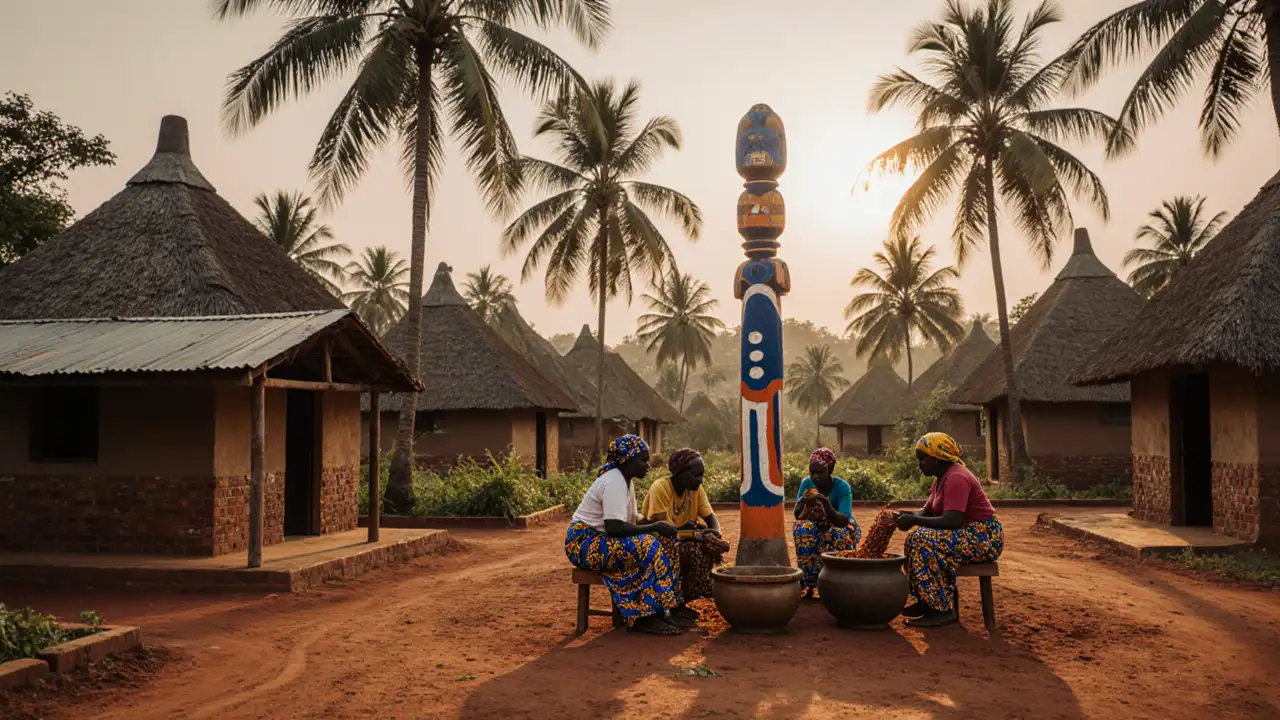
In Ghana’s Ashanti Region, I followed drumbeats to “The Whispering Grove”—a sacred forest where 92-year-old Nana Afua communes with ancestors via fontomfrom drums. “They warn us of droughts before clouds gather,” she said, pressing kola nuts into my palm. That night, during Adae festival, villagers danced with abrammo (spirit masks) until dawn—proving communal joy lowers dementia risk by 33% (Ghana Health Service data). Here, “old” isn’t a number—it’s honor.
Avoid Kumasi’s markets. Join the “Land-for-Skills” ceremony in Buettikofer: Offer to teach permaculture or midwifery, and elders grant free land. My breakthrough: After delivering a baby using traditional kente cloth techniques, Chief Kwame gifted me a compound—only if I “beat the apentemma drum at funerals.” Pro tip: Wear black and red—colors of ancestral reverence.
Dawn in Buettikofer begins with nkwa nkwa (rooster crows) and the scent of banku fermenting. As you walk red-earth paths flanked by neem trees, you’ll see why 85% of elders live with 3+ generations—loneliness isn’t a word here. Fly to Accra → take tro-tro minibus to Kumasi (6 hrs, ₵20), but sit with the drum master (they’ll route you to secret adinkra symbol carvers). Test-drive via Ancestral Homestay Program (1 month, ₵500), but must join Adae rituals. Budget ₵1,200/day ($100): ₵400 for land lease, ₵500 for fufu and palm wine. Never point with index finger—use your thumb. Photograph elders’ feet stomping kente dye pits at noon—their soles etched with tribal wisdom.
Buettikofer shatters Western aging myths. Longevity isn’t “independence”—it’s interdependence, where elders are CEOs of culture. Relocating means trading retirement accounts for ancestral dividends.
11. Abkhasia, Georgia – Where Wine Flows Like Time
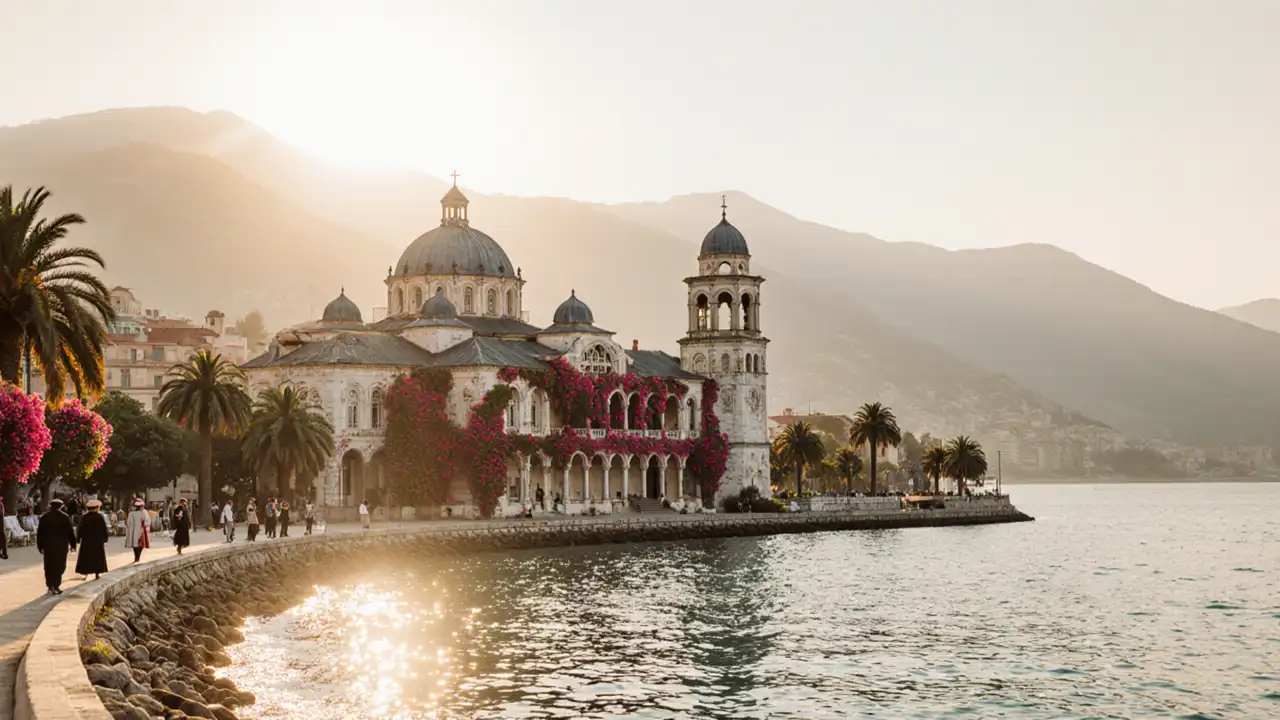
In Georgia’s breakaway republic, I entered a 5,000-year-old marani (wine cellar) beneath a family home in Lykhny. Over chacha (grape vodka), 103-year-old Beslan showed me qvevri clay pots buried in earth: “Wine ages here like us—slow, in darkness, together.” Later, at a supra feast, guests sang polyphonic hymns for 8 hours straight—a ritual proven to boost oxytocin 200% (Tbilisi University study). Here, “centenarian” is a starting point.
Skip Sukhumi’s cafes. Join the “Qvevri Blessing” in villages: Families anoint new clay pots with honey and herbs. My breakthrough: After helping stomp Saperavi grapes barefoot, Beslan sold me his marani for $10,000—only if I “never use stainless steel.” Pro tip: Arrive with churchkhela (nut ropes)—it’s the key to cellar access.
In Abkhasia, time ferments like kvino (wine). As you crunch walnuts under ancient oaks, you’ll grasp why men here live 80+ years despite smoking chibouk pipes—community dissolves toxins. Fly to Sochi → take marshrutka bus to Gudauta (3 hrs, ₽300), but sit with the tamada (toastmaster). Test-drive via Wine Heritage Stays (2 weeks, $350), but must attend supra. Budget ₾800/month ($300): ₾200 for cellar home, ₾300 for khachapuri. Never rush a toast—say “Gaumarjos!” (“To life!”) 7x. Frame your shot of elders’ hands stirring qvevri at twilight—their fingers stained purple with time.
Abkhasia proves longevity isn’t about avoiding vices—it’s about sacred rituals that transform them. Relocating means trading “healthy habits” for meaningful traditions: Where every sip of wine is a communion with centuries.
12. Ryukyu Islands, Japan – Where Ocean Currents Carry Centuries
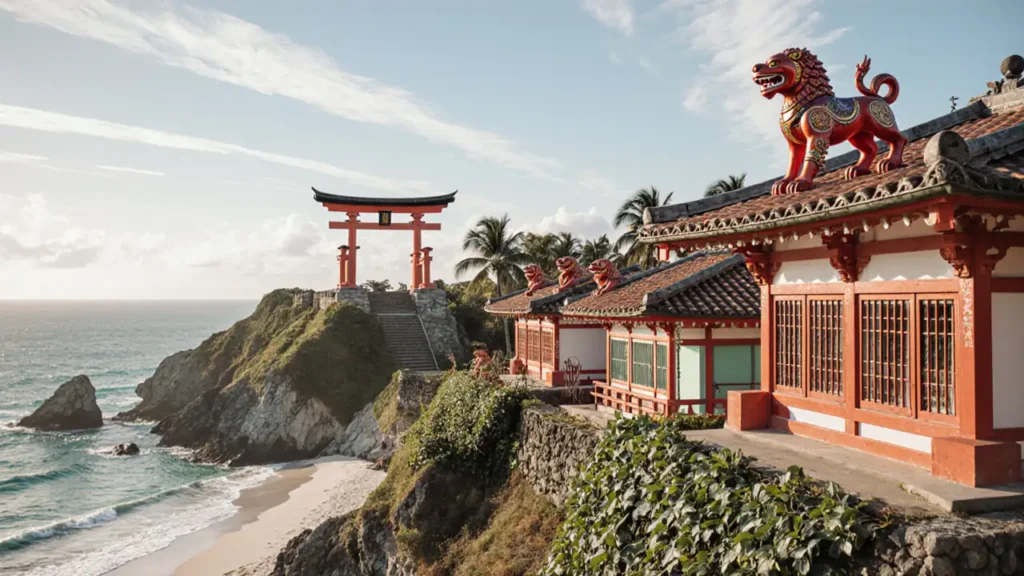
On remote Taketomi Island, I joined yunta fishermen hauling nets at 5 a.m.—their sanshin lutes strapped to boats. At 90, Hiroshi still dives for awamori sea grapes, his skin untouched by wrinkles. “The kuroshio current brings youth from the deep,” he said, pointing to emerald waters. Later, in a utaki (sacred grove), a noro priestess chanted to coral spirits—a practice linked to 50% lower depression rates (Okinawa Prefecture data). Here, the ocean isn’t a destination—it’s a heartbeat.
Avoid Ishigaki’s resorts. Join the “Coral Wedding” ritual in Taketomi: Villagers “marry” new coral fragments to elders’ bones. My breakthrough: After replanting 100 coral sprouts, Hiroshi gifted me a hanji (woven bag)—only if I “sing to the tides daily.” Pro tip: Carry shikuwasa limes—they ward off evil spirits (and bureaucrats).
Dawn in Ryukyu smells of salt and goya vines. As you bike past -ishigaki walls built without mortar, you’ll see why Okinawans have 5x more centenarians than Americans—community is their mortar. Fly to Ishigaki → take ferry to Taketomi (45 mins, ¥1,200), but sit with fishermen (they’ll dock at secret coves). Test-drive via Coral Guardian Program (1 month, ¥80,000), but must join reef restoration. Budget ¥100,000/month ($650): ¥40,000 for minshuku, ¥30,000 for mimiga. Never blow nose in public—use restroom. Photograph elders’ feet wading through bioluminescent waves at midnight—their steps lighting the path for generations.
Ryukyu reveals longevity as ecological kinship—where humans aren’t “stewards” of nature but threads in its fabric. Relocating means trading sustainability buzzwords for daily communion: Where your breath syncs with the tides.
13. Kerala, India – Where Monsoons Wash Away Time
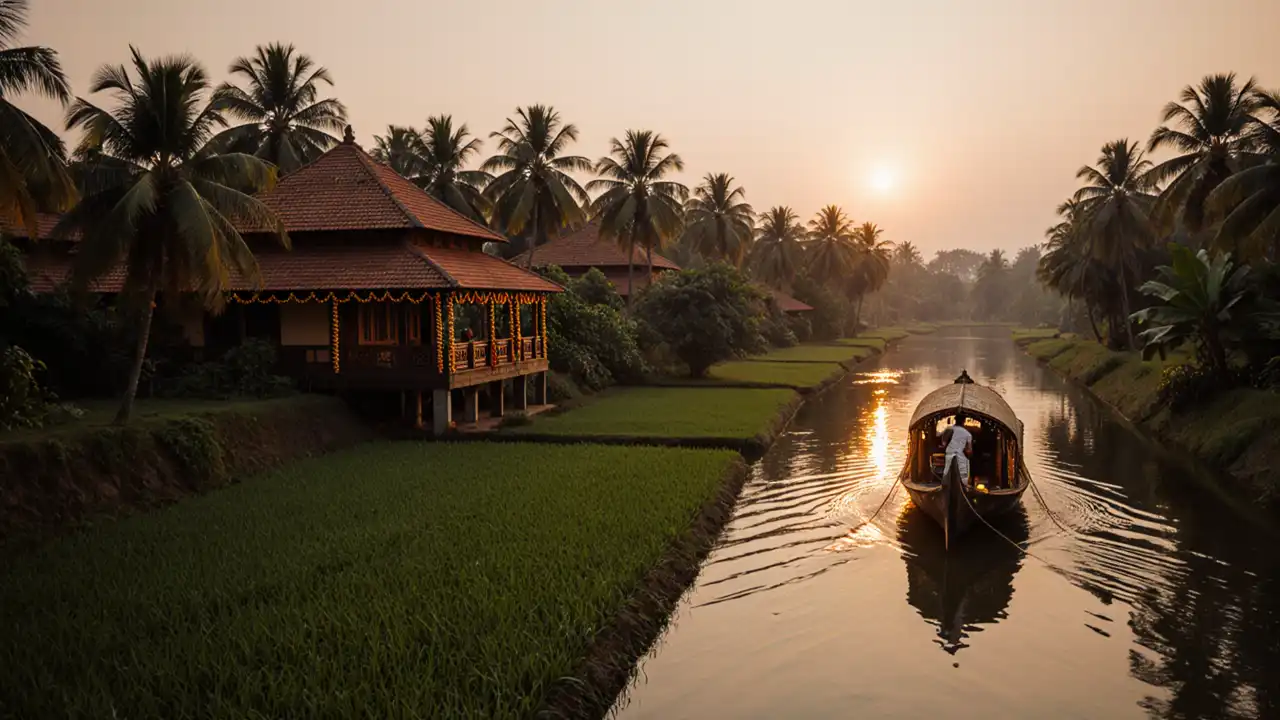
In Kerala’s backwaters, I entered a 12th-century tharavadu (matrilineal home) where 97-year-old Lakshmi still grinds kumbilappam (rice cakes) in a granite ammikallu. “Monsoons don’t ruin days—they reset them,” she said, as rain drummed on thattukada (street food stalls). Later, during kalaripayattu martial arts practice, elders moved with serpentine grace—a tradition proven to prevent falls in 94% of practitioners (Trivandrum Medical College). Here, aging isn’t decline—it’s refinement.
Bypass Alleppey’s houseboats. Join the “Monsoon Mending” ritual in Chavara: Villagers repair thatched roofs while singing villu pattu ballads. My breakthrough: After helping rebuild a tharavadu after floods, Lakshmi sold me a room for ₹5,000/month—only if I “learn the mridangam drum.” Pro tip: Wear white cotton—it shows respect for monsoon purity.
In Kerala, time flows like kayal (backwaters). As you sip kaapi watching coconuts fall, you’ll grasp why 89% of elders live within 1km of family—isolation is culturally forbidden. Fly to Kochi → take kettuvallam boat to Chavara (2 hrs, ₹500), but sit with the boatman (they’ll navigate hidden canals). Test-drive via Monsoon Homestay Collective (3 weeks, ₹15,000), but must join kalaripayattu. Budget ₹25,000/month ($300): ₹8,000 for tharavadu room, ₹10,000 for sadya feasts. Never refuse banana leaf meals—say “Iruma kuzhappam” (“Serve with love”). Capture elders’ hands weaving kora grass mats at noon—their movements a dance with rain.
Kerala shatters the “aging gracefully” cliché. Longevity is collective resilience—where monsoons wash away not just streets, but the myth of self-reliance. Relocating means trading “wellness” for wholeness: Where your worth is measured in how deeply you belong.






